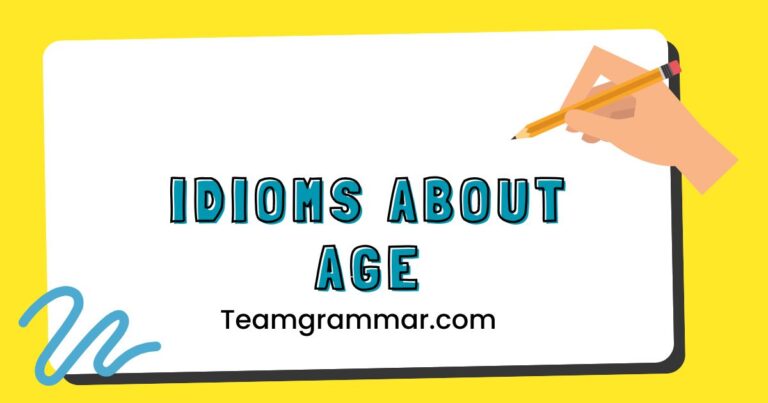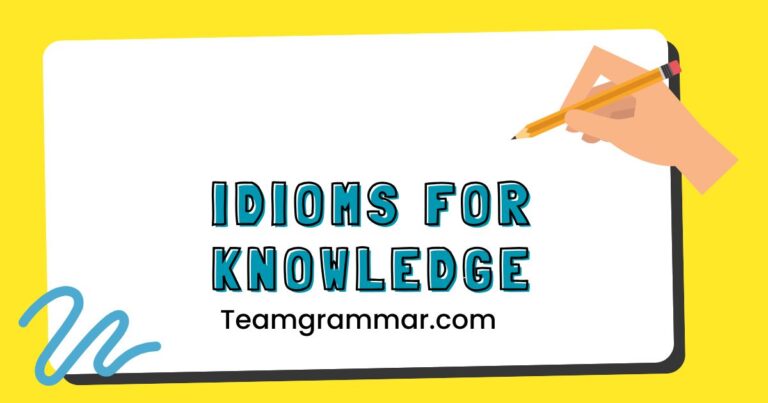33 Mastering Idioms: A Guide to Conversational English
Idioms are the colorful building blocks of natural, fluent English. They add depth, nuance, and personality to your conversations, making you sound more like a native speaker.
However, idioms can be tricky; their meanings aren’t always obvious from the individual words. This article provides a comprehensive guide to understanding and using idioms effectively in everyday conversation.
Whether you’re a beginner or an advanced learner, mastering idioms will significantly enhance your comprehension and communication skills, allowing you to express yourself more vividly and connect with others on a deeper level. This detailed exploration will equip you with the knowledge and practice needed to confidently incorporate idioms into your spoken and written English.
By learning idioms, you’ll unlock a deeper understanding of cultural contexts and subtle communication cues. This guide offers a structured approach, complete with definitions, examples, usage rules, and practice exercises to help you integrate idioms seamlessly into your everyday language use.
Prepare to transform your conversational skills by delving into the fascinating world of English idioms.
Table of Contents
- Definition of Idioms
- Structural Breakdown of Idioms
- Types and Categories of Idioms
- Examples of Idioms in Conversation
- Usage Rules for Idioms
- Common Mistakes with Idioms
- Practice Exercises
- Advanced Topics in Idioms
- Frequently Asked Questions About Idioms
- Conclusion
Definition of Idioms
An idiom is a phrase or expression whose meaning cannot be understood from the literal meanings of its individual words. Instead, it has a figurative meaning that is known through common use.
Idioms are a crucial part of any language, especially English, adding color and depth to everyday conversation. They reflect cultural nuances and historical contexts, often providing insights into a society’s values and beliefs.
Understanding idioms is essential for achieving fluency and truly grasping the subtleties of the English language. Without this understanding, conversations might be misinterpreted, and the speaker’s intended meaning could be entirely missed.
Therefore, mastering idioms is a significant step toward mastering English.
Idioms can be classified based on their structure and the grammatical role they play in a sentence. They can function as verbs, nouns, adjectives, or adverbs, although their internal structure might not always align with their function.
For example, the idiom “kick the bucket” functions as a verb meaning “to die,” even though “bucket” is a noun. The context in which an idiom is used is vital for determining its meaning.
Recognizing an idiom can sometimes be challenging because the words themselves might seem familiar, but their combined meaning is unique and specific. This is where a strong understanding of common idioms becomes invaluable.
Learning idioms is an ongoing process, as new expressions emerge and old ones evolve over time. This dynamic nature makes the study of idioms both fascinating and essential for effective communication.
Structural Breakdown of Idioms
The structure of idioms can vary widely, from simple two-word phrases to more complex sentences. However, the key characteristic is that the meaning of the whole idiom is different from the sum of its parts.
Understanding the structural elements can help learners identify and remember idioms more easily. One common structural pattern involves a verb and a preposition, such as “look into” (to investigate) or “get over” (to recover from).
Another pattern includes nouns and adjectives used in a figurative way, like “a piece of cake” (very easy) or “raining cats and dogs” (raining heavily). The fixed nature of idioms is also important; you usually can’t change the words or their order without altering or losing the idiom’s meaning.
This rigidity distinguishes idioms from regular phrases where you can substitute words freely.
Idioms often contain metaphorical or figurative language, which contributes to their non-literal meaning. For example, “break the ice” uses the metaphor of breaking a physical barrier to represent initiating a conversation in a social setting.
The use of imagery and symbolism is common in idioms, making them memorable and expressive. Furthermore, many idioms have historical or cultural origins that explain their unique meanings.
Knowing the etymology of an idiom can sometimes provide a deeper understanding and help with retention. Analyzing the structure of idioms involves recognizing these patterns and understanding how the individual words contribute to the overall figurative meaning.
This analytical approach can make learning idioms more efficient and enjoyable.
Types and Categories of Idioms
Idioms can be categorized based on their grammatical structure or their semantic function. Here are some common categories:
Verb Idioms
These idioms use a verb as the main component and often include prepositions or adverbs. They describe actions or states of being in a non-literal way.
Prepositional Idioms
These idioms rely heavily on prepositions to create a specific meaning. The preposition is crucial to the idiom’s overall sense.
Adjective Idioms
These idioms use adjectives to describe something in a figurative or exaggerated way.
Simile Idioms
These idioms use similes (comparisons using “like” or “as”) to create a vivid image or description.
Metaphor Idioms
These idioms use metaphors (direct comparisons without “like” or “as”) to convey a non-literal meaning.
Binomial Idioms
These idioms consist of two words joined by a conjunction, usually “and” or “or.” The order of the words is often fixed.
Examples of Idioms in Conversation
Understanding idioms requires seeing them in context. The following tables provide examples of idioms categorized by type, along with their meanings and example sentences.
These examples are designed to illustrate how idioms are used in everyday conversation and to help you recognize and understand them more effectively.
The examples provided cover a wide range of topics and situations, ensuring that you encounter idioms in various contexts. Pay attention to how the idioms fit into the sentences and how they contribute to the overall meaning.
By studying these examples, you will develop a stronger sense of how to use idioms naturally and appropriately.
Here’s a table of verb idioms:
| Idiom | Meaning | Example Sentence |
|---|---|---|
| Break the ice | To initiate a conversation or activity to ease tension | He told a joke to break the ice at the meeting. |
| Call it a day | To stop working on something | We’ve been working for hours; let’s call it a day. |
| Get out of hand | To become unmanageable or out of control | The party got out of hand, and the neighbors complained. |
| Keep an eye on | To watch someone or something carefully | Can you keep an eye on my bag while I go to the restroom? |
| Let the cat out of the bag | To reveal a secret | I didn’t mean to let the cat out of the bag about the surprise party. |
| Miss the boat | To miss an opportunity | If you don’t apply now, you’ll miss the boat. |
| Pull someone’s leg | To tease or joke with someone | Are you serious, or are you just pulling my leg? |
| See eye to eye | To agree with someone | They finally saw eye to eye on the business deal. |
| Spill the beans | To reveal a secret | Come on, spill the beans! What happened last night? |
| Take with a grain of salt | To not take something too seriously | You should take his advice with a grain of salt. |
| Hit the nail on the head | To be exactly right | You’ve hit the nail on the head with that suggestion. |
| Beat around the bush | To avoid talking directly about something | Stop beating around the bush and tell me what you really think. |
| Bite the bullet | To face a difficult situation with courage | I hate going to the dentist, but I’ll just have to bite the bullet. |
| Cut corners | To do something poorly in order to save money or time | The company cut corners on safety, and it led to an accident. |
| Drive someone up the wall | To irritate or annoy someone greatly | His constant complaining is driving me up the wall. |
| Face the music | To accept the consequences of one’s actions | He knew he was wrong, and he had to face the music. |
| Get something off your chest | To talk about something that has been bothering you | I need to get this off my chest; I’m really unhappy at work. |
| Jump the gun | To start something too early | They jumped the gun and announced the product before it was ready. |
| Kick the bucket | To die (informal) | He’s quite old now, but he’s determined not to kick the bucket anytime soon. |
| Leave no stone unturned | To try every possible course of action | The detective left no stone unturned in his search for the truth. |
| Make a long story short | To summarize something quickly | To make a long story short, we won the competition. |
| On the ball | Alert and competent | Our new assistant is really on the ball. |
| Play it by ear | To improvise or decide things as you go | We don’t have a plan; let’s just play it by ear. |
| Rock the boat | To cause trouble or disrupt a stable situation | I don’t want to rock the boat, so I won’t say anything negative. |
| Sit tight | To wait patiently | Sit tight; the doctor will see you soon. |
| Take the plunge | To make a bold or important decision | After thinking about it for years, they finally decided to take the plunge and get married. |
| Under the weather | Not feeling well | I’m feeling a bit under the weather today. |
| Wrap your head around | To understand something complicated | I can’t wrap my head around this new software. |
The following table provides examples of adjective idioms, showcasing their use in descriptive contexts.
| Idiom | Meaning | Example Sentence |
|---|---|---|
| All ears | Eager to listen | Tell me about your trip; I’m all ears. |
| Bright as a button | Intelligent and lively | She’s as bright as a button and always eager to learn. |
| Cool as a cucumber | Calm and composed, especially in a stressful situation | He was as cool as a cucumber during the presentation. |
| Dead tired | Extremely tired | After the marathon, I was dead tired. |
| Easy as pie | Very easy | The test was as easy as pie. |
| Fit as a fiddle | In excellent physical condition | He’s 80 years old but still as fit as a fiddle. |
| Good as gold | Well-behaved and obedient | The children were as good as gold during the church service. |
| Happy as a clam | Very happy | She’s as happy as a clam since she got the new job. |
| In the doghouse | In trouble or disfavor | He’s in the doghouse with his wife for forgetting their anniversary. |
| Mad as a hatter | Completely crazy | He’s as mad as a hatter with his wild ideas. |
| On cloud nine | Extremely happy | She’s been on cloud nine since she got engaged. |
| Pale as a ghost | Very pale, usually from fear or shock | She looked as pale as a ghost after seeing the accident. |
| Quick as a flash | Very fast | He was as quick as a flash, catching the ball before it hit the ground. |
| Right as rain | Perfectly fine | After a good night’s sleep, I’ll be right as rain. |
| Safe and sound | unharmed and well | They arrived home safe and sound after the storm. |
| Sick as a dog | Very ill | I was sick as a dog after eating that bad seafood. |
| Tough as nails | Strong and resilient | He’s as tough as nails and never gives up. |
| Ugly as sin | Extremely ugly | That old car is as ugly as sin. |
| Vain as a peacock | Excessively proud of one’s appearance | She’s as vain as a peacock, always admiring herself in the mirror. |
| Wise as an owl | Very wise and knowledgeable | My grandfather is as wise as an owl and always gives good advice. |
| Young at heart | Having a youthful spirit | Despite his age, he’s still young at heart. |
| Zealous as a bee | Extremely enthusiastic | She’s as zealous as a bee when it comes to environmental causes. |
| Black and blue | Covered in bruises | After the fall, his legs were black and blue. |
| Clear as mud | Not clear at all; confusing | His explanation was as clear as mud. |
| Dry as a bone | Extremely dry | The desert air is as dry as a bone. |
| Green as grass | Inexperienced or naive | He’s as green as grass when it comes to business. |
| Hot as hell | Extremely hot | The weather today is as hot as hell. |
Here’s a table illustrating prepositional idioms and their typical uses:
| Idiom | Meaning | Example Sentence |
|---|---|---|
| On the dot | Exactly on time | The meeting started at 9 on the dot. |
| In a nutshell | In brief; in summary | In a nutshell, the project was a success. |
| Out of the blue | Unexpectedly | He called me out of the blue after many years. |
| Over the moon | Extremely happy | She was over the moon about her new job. |
| Under the weather | Feeling ill | I’m feeling a bit under the weather today. |
| By the skin of your teeth | Barely succeeding | I passed the exam by the skin of my teeth. |
| At the drop of a hat | Immediately; without hesitation | He’s ready to help at the drop of a hat. |
| In the same boat | In the same situation | We’re all in the same boat when it comes to the economy. |
| Off the top of my head | From memory; without precise knowledge | Off the top of my head, I’d say it costs about $50. |
| On the fence | Undecided | I’m still on the fence about which college to attend. |
| Against the clock | Rushed; under time pressure | We were working against the clock to finish the project. |
| Down in the dumps | Sad or depressed | She’s been down in the dumps since she lost her job. |
| In deep water | In serious trouble | He’s in deep water with the IRS. |
| Off the hook | Free from obligation or blame | He’s off the hook because someone else confessed. |
| On the ball | Alert and competent | Our new assistant is really on the ball. |
| Up in the air | Uncertain; undecided | Our travel plans are still up in the air. |
| With flying colors | With great success | She passed the test with flying colors. |
| Beyond the pale | Unacceptable | His behavior was beyond the pale. |
| By leaps and bounds | Rapidly; significantly | The company is growing by leaps and bounds. |
| In the long run | Eventually; over a long period | In the long run, this investment will pay off. |
| On second thought | After reconsidering | On second thought, I won’t go to the party. |
| To the bitter end | Until the end, no matter how difficult | He fought for his beliefs to the bitter end. |
| Under one’s breath | In a quiet voice | She muttered something under her breath. |
| Out of sorts | Slightly unwell or unhappy | I’ve been feeling a bit out of sorts lately. |
| For good | Permanently | They left the country for good. |
Usage Rules for Idioms
Using idioms correctly involves understanding their specific meanings and contexts. Here are some key rules to keep in mind:
- Context is Key: Always consider the context of the conversation. Idioms can be inappropriate in formal or serious settings.
- Fixed Structure: Idioms typically have a fixed structure. Changing the words or their order can alter or destroy the meaning. For example, saying “spill the potatoes” instead of “spill the beans” makes no sense.
- Cultural Sensitivity: Be aware that some idioms are culturally specific and might not be understood or appreciated by everyone.
- Appropriate Use: Use idioms sparingly. Overusing them can make your speech sound unnatural or contrived.
- Understanding the Nuances: Some idioms have subtle variations in meaning depending on the context. Pay attention to these nuances to use them accurately.
- Verb Tense: The verbs within idioms can be conjugated to fit the tense of the sentence. For example, “He kicked the bucket” (past tense).
- Subject-Verb Agreement: Ensure that the verb in the idiom agrees with the subject of the sentence.
Understanding the nuances of idiom usage is crucial for effective communication. While idioms can add color and depth to your conversations, using them incorrectly can lead to confusion or misinterpretation.
Therefore, it’s important to study idioms in context and to practice using them in different situations.
Common Mistakes with Idioms
One of the most common mistakes with idioms is taking them literally. Because idioms have figurative meanings, interpreting them word-for-word can lead to misunderstandings and humorous errors.
Another frequent mistake is altering the words or structure of an idiom, which can change its meaning or make it nonsensical. Here are some specific examples of common mistakes and their corrections:
| Incorrect | Correct | Explanation |
|---|---|---|
| “He was pulling my foot.” | “He was pulling my leg.” | The correct idiom is “pulling my leg,” meaning to tease or joke with someone. |
| “Let the dog out of the bag.” | “Let the cat out of the bag.” | The idiom is “let the cat out of the bag,” meaning to reveal a secret. |
| “It’s a slice of cake.” | “It’s a piece of cake.” | The correct idiom is “a piece of cake,” meaning something is very easy. |
| “Under the climate.” | “Under the weather.” | The idiom is “under the weather,” meaning to feel unwell. |
| “Hit the nail on the head.” | “Hit the nail on the head.” | This idiom is already correct, meaning to be exactly right. |
| “Break a leg!” (said to someone before surgery) | “Break a leg!” (said to someone before a performance) | “Break a leg” is only appropriate before a performance, meaning “good luck.” It’s inappropriate in other contexts. |
Avoiding these common mistakes requires careful attention to detail and a solid understanding of idiom usage. By studying examples of correct and incorrect usage, learners can improve their accuracy and confidence when using idioms in conversation.
Practice Exercises
Test your understanding of idioms with these practice exercises. Choose the correct idiom to complete each sentence.
| Question | Options | Answer |
|---|---|---|
| 1. I was so nervous about the interview, but I decided to just ____ and hope for the best. | a) bite the apple b) bite the bullet c) bite the dust | b) bite the bullet |
| 2. The company is trying to ____ by using cheaper materials, but it’s affecting the quality of their products. | a) cut squares b) cut circles c) cut corners | c) cut corners |
| 3. His constant complaining is starting to ____. | a) drive me up the wall b) drive me to the door c) drive me to the window | a) drive me up the wall |
| 4. After lying to his boss, he had to ____. | a) face the music b) face the crowd c) face the world | a) face the music |
| 5. I need to ____ about how unhappy I am at my job. | a) get it off my shoulder b) get it off my back c) get it off my chest | c) get it off my chest |
| 6. They ____ and announced the product before it was ready. | a) jumped the shark b) jumped the gun c) jumped the fence | b) jumped the gun |
| 7. The detective ____ in his search for the truth. | a) left no stone unturned b) left no page unread c) left no tree unclimbed | a) left no stone unturned |
| 8. ____, we won the competition. | a) To make a short story long b) To make a long story short c) To make a story interesting | b) To make a long story short |
| 9. Our new assistant is really ____. | a) on the moon b) on the earth c) on the ball | c) on the ball |
| 10. We don’t have a plan; let’s just ____. | a) play it by heart b) play it by ear c) play it by mind | b) play it by ear |
Here’s another exercise focusing on matching idioms to their meanings:
| Idiom | Meaning |
|---|---|
| 1. Break the ice | a) To miss an opportunity |
| 2. Call it a day | b) To agree with someone |
| 3. Miss the boat | c) To stop working on something |
| 4. See eye to eye | d) To initiate a conversation to ease tension |
Answers:
- 1 – d
- 2 – c
- 3 – a
- 4 – b
Advanced Topics in Idioms
For advanced learners, exploring the etymology and historical context of idioms can provide a deeper understanding and appreciation of their usage. Many idioms have fascinating origins that reflect cultural practices, historical events, or literary references.
For example, the idiom “raining cats and dogs” is believed to have originated in 16th-century England, when heavy rainstorms would wash dead animals down the streets, creating the impression that it was literally raining cats and dogs.
Another advanced topic is the use of idioms in literature and rhetoric. Authors and speakers often use idioms to add color and emphasis to their writing or speech.
Recognizing and analyzing the use of idioms in different literary genres can enhance your comprehension and analytical skills. Furthermore, understanding how idioms are translated and adapted in different languages can provide insights into cross-cultural communication and linguistic diversity.
This deeper exploration of idioms can significantly enhance your overall language proficiency and cultural awareness.
Frequently Asked Questions About Idioms
- What is the difference between an idiom and a proverb?
An idiom is a phrase whose meaning is not predictable from the usual meanings of its elements (e.g., “kick the bucket”). A proverb is a short, popular saying that provides advice or expresses a general truth (e.g., “Actions speak louder than words”). - How can I learn idioms effectively?
The best way to learn idioms is through exposure and context. Read widely, listen to native speakers, and pay attention to how idioms are used in different situations. Keep a notebook of new idioms and practice using them in your own speech and writing. - Are idioms the same in all English-speaking countries?
No, idioms can vary significantly between different English-speaking countries and regions. Some idioms are specific to British English, American English, Australian English, etc. Be aware of these regional differences to avoid confusion. - Is it okay to use idioms in formal writing?
Generally, idioms are best avoided in formal writing, as they can make your language sound less professional. However, in some cases, a well-chosen idiom can add emphasis or color to your writing, so use your judgment. - How can I avoid misusing idioms?
To avoid misusing idioms, always check their meaning and usage in a reliable dictionary or online resource. Pay attention to the context in which they are used and practice using them in different situations. - Can I create my own idioms?
While it’s possible to create new phrases, they won’t be idioms unless they gain widespread use and acceptance. Idioms are, by definition, expressions that are commonly understood and used by native speakers. - Why are idioms so difficult to understand for non-native speakers?
Idioms are difficult because their meanings are not literal and must be learned through exposure and context. They often rely on cultural or historical references that may be unfamiliar to non-native speakers. - Are there any online resources that can help me learn idioms?
Yes, there are many online resources that can help you learn idioms, including dictionaries, websites, and language learning apps. Some popular resources include the Oxford Learner’s Dictionaries, Merriam-Webster’s Learner’s Dictionary, and various idiom-focused websites and apps. - How do I know when an expression is an idiom and not just a regular phrase?
If the meaning of an expression is different from the literal meanings of its individual words, it’s likely an idiom. Also, idioms often have a fixed structure and cannot be easily changed without losing their meaning. - What should I do if I don’t understand an idiom in a conversation?
Don’t be afraid to ask for clarification. You can say something like, “I’m sorry, I didn’t understand that idiom. Could you explain what it means?” Most native speakers will be happy to help.
Conclusion
Mastering idioms is a journey that significantly enhances your English language skills. By understanding the definitions, structural nuances, and usage rules of idioms, you can add depth and color to your conversations, making you sound more natural and fluent.
This guide provided a comprehensive overview of idioms, including various types, examples, usage rules, common mistakes, and practice exercises. Remember that learning idioms is an ongoing process that requires continuous exposure and practice.
Embracing the challenge of learning idioms will not only improve your language proficiency but also deepen your understanding of English-speaking cultures.
Continue to explore and incorporate new idioms into your vocabulary, and don’t be afraid to use them in your daily conversations. The more you practice, the more comfortable and confident you will become.
Pay attention to how native speakers use idioms and try to emulate their usage. With dedication and perseverance, you can master the art of using idioms effectively and elevate your English communication skills to a new level.
Keep practicing and enjoy the journey of learning!







